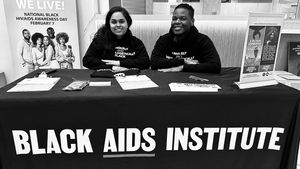Aydian Dowling, a transgender man, is the front-runner in the popular vote in the 2015 Men's Health Ultimate Guy Cover Contest, having led voting for weeks. The contest is open for entries until June 21, and the voting represents only 10 percent of the overall judging criteria -- but if he wins the contest, Dowling's photo will appear on the cover of the magazine's November issue.
It's worth noting that Dowling isn't the only openly trans man in the running for Men's Health's "Ultimate Guy." Army Sgt. Shane Ortega, who also happens to be the first out trans person in the U.S. military, has also thrown his hat in the ring to be on the magazine's November cover. See his Men's Health profile here.
There are a plethora of reasons that this is amazing:
It Broadens the Concept of What a Trans Man Is
What does the world think of when they think of transgender men? If you ask most people, and make them answer without Googling, they might bring up Chaz Bono -- the trans son of Cher and Sonny Bono. Or, they might mention Thomas Beatie, who found notoriety in the 'Aughts when he was declared the world's first "pregnant man." Both men are valuable representations.
But there's no harm in broadening our currently narrow scope, expanding our horizons, and having different images of what transgender men look like. If that image happens to come in the form of an attractive and physically fit trans man, so be it. Sure, not all trans guys look like Dowling or Ortega, but there is nothing wrong with showing the world that some do.
It Validates Trans* Self-Concept
Most trans men have spent a considerable amount of time being viewed as female. We know all too well the ridiculous expectations of female beauty standards. These standards are harsh and steeped in patriarchal constructs. Since most of us did not come anywhere close to living up to society's expectations of the "ideal woman," we received a disproportionate amount of criticism for our appearance. These invalidating moments are stored in our memory banks, to be revisited on a continual basis. The fact that many us rarely received positive feedback about our appearance has left a big hole in our self-esteems.
For those of us who physically transition, the changes are welcomed and exciting; we finally get to see ourselves as we always thought we should be, sometimes with features like a stubbly beard, muscular forearms, and sturdy chest. It feels satisfying, but nevertheless, it does not change the past. We still have those memories that can inform our current perspective of ourselves. So, to have one of our own be publicly recognized as the "ultimate guy" on the cover of a major magazine, helps us see ourselves as men worthy of adoration and adulation.
It Helps Trans* People Authentically Share Our Identities
Transgender people are a small minority; even though right now it seems like we are multiplying, we aren't. There are a few transgender people getting some long overdue attention -- Laverne Cox, Bruce Jenner, Chaz -- partly because of the work of countless transgender warriors who have been fighting for change and visibility for decades. But this recent interest in the trans community does not erase the reality of this uphill journey.
Those of us who seek to physically transition accept a deal: a quid pro quo situation -- this for that. For trans men who take testosterone, we get male secondary sex characteristics and the satisfaction of an identity that fits our true sense of self. These are all amazing things, but these things do not come without a cost. We give up overall societal approval. We enter into the world of an outsider.
We assume an unconventional existence that requires explanations at almost every turn. It's not easy to explain to people that you are transgender, especially when you know that much of society views you as a complete deviant, someone who does not even deserve to be called by the correct pronoun. At the same time, it's not easy to not explain that you are transgender. There is a cost to living a stealth life. It's not easy to form a healthy sense of yourself when you are not open about who you are. As many a person who has "passed" will tell you, it has a way of slowly suffocating you. So, when an image comes along that appeals to the masses in the way that Dowling's physique does, we as trans people can use it to draw the strength and confidence we need to be open and authentic about our lives.
It Promotes a Healthy Lifestyle for Trans People
Healthy does not have to mean ripped with muscles, but it sure looks good when it does. While not every trans man needs to embark on a body-builder's workout routine, it's helpful for trans men to see healthy representations of themselves. Many transgender people have mixed relationships with their bodies. Dysphoric feelings about one's body are pretty much the norm for transgender people. Individuals who have gender dysphoria experience "a marked incongruence between one's experienced/expressed gender and assigned gender," as the American Psychiatric Association defines it. It can be a daunting task to try and reshape our bodies in the face of gender dysphoria. The depression that often accompanies the condition can also sideline efforts for achieving an active and healthy lifestyle.
To see other trans men achieve a sculpted, healthy physique can serve as a powerful motivator for other trans men to get fit.

It Publicly Brings Trans Men Into the Realm of the Desirable
There is a notion of transgender men as pity cases; many people think that our only hope of a potential partner is someone as "deviant" as ourselves, as I've heard. Of course, many of us have amazing partners who are beautiful and selective. They chose us because we are attractive and valuable human beings and, yes, desirable.
This concept, the idea that a transgender man could be a "catch," may be foreign to many people. If the image of a muscled Dowling or Ortega helps to showcase the desirability of transgender men, I am in complete support. Let it also be known that there are more men like them out there, in all different races, ethnicities, shapes, and sizes.
*Editor's Note: The asterisk after the word trans indicates its usage as an umbrella term that aims to reflect the vast diversity of identities and experiences of individuals who identify as transgender, transsexual, intersex, nonbinary, and otherwise gender-nonconforming.
AUGUST FAUSTINO is a trans man from Los Angeles.






































































